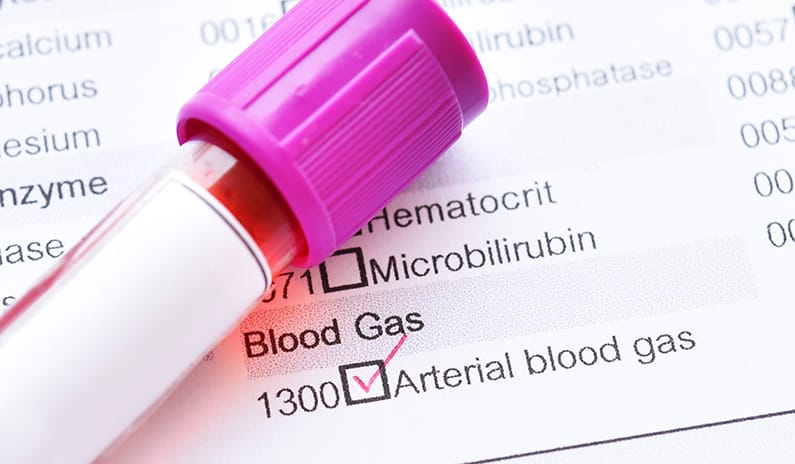Blood Gas Analysis (BGA) is a diagnostic tool that provides an objective assessment of a patient’s oxygen supply, ventilation and acid-base balance. With only 4 steps it is possible to analyse a blood gas analysis!
Why should arterial blood gas be monitored?
The results of a BGA mainly show how well the oxygenation of your patient works. BGAs can not only provide information about ventilation, but also about how well your patient’s kidneys and other internal organs (metabolism) are functioning. Although all the data from a BGA analysis can be useful, it is possible to interpret the results accurately without taking all the values into account.
Focus especially on these 6 values
#1 + 2: Oxygen partial pressure (pO2) and oxygen saturation (SaO2)
Oxygen saturation (SaO2) measures how well haemoglobin is saturated in the blood. The SaO2 value derived from a blood gas is very similar to the SpO2 value from pulse oximetry. The SaO2 value derived from a blood gas is very similar to the SpO2 value from pulse oximetry. The only difference is that we measure the saturation of arterial blood (SaO2) in a blood gas and the saturation of peripheral capillary blood (SpO2) in pulse oximetry. In practice, the differences between these 2 values are negligible. Standard values are values between 95-100% saturation (SaO2 or SpO2).
As a rule, the oxygen partial pressure (pO2) correlates with the oxygen saturation (SaO2).
Normal pO2 values are 70-90 mmHg for room air.
#3 + 4: Bicarbonate concentration (HCO3) and excess base – Base-Excess (BE)
Simply put, the bicarbonate concentration (HCO3) and the base excess (BE) provide information on how much buffer is present in the blood. This shows how well the patient’s metabolic system, which is closely related to kidney function, functions.
HCO3 and BE are called metabolic parameters. The normal range for HCO3 is 22-26 mmol/l and for the base-excess (BE) -2 to +2. Since these two values measure essentially the same, it is not necessary to consider both.
#5: Carbon dioxide concentration (pCO2)
The carbon dioxide concentration (pCO2) provides information on ventilation and indicates whether the lungs are working effectively. For this reason, pCO2 is often referred to as the airway parameter. The pCO2 indicates how much carbon dioxide a patient has in his blood. The normal range is 35-40 mmHg.
#6: Hydrogen ion concentration (pH value)
The hydrogen ion concentration (pH value) provides information about the acid-base balance. This refers to the amount of acid or bases a patient has in the blood. The pH scale uses values from one to 14 to indicate whether a solution is acidic, neutral or alkaline / alkaline.
For the body to work effectively, the pH of the arterial blood must be 7.4. Only small deviations can be tolerated without negative effects. Thus, within an arterial blood gas, the normal range for the pH value should be 7.35-7.45. Simply put, if the pH is in the 7.35-7.45 range, the acids and bases in the blood are properly balanced.
Because small changes in pH are life-threatening, mechanisms to maintain acid-base balance are essential. Although the pH scale measures 1.0-14.0, a blood pH of < 7,0 or > 8.0 makes a patient’s survival almost impossible. Therefore, the body relies on a number of buffers to counteract dramatic changes in blood pH.
All standard values at a glance
- pH = 7,35-7,45 ; < 7,35: acidosis; > 7,45: alkalosis
- pO2 = 75-97 mmHg
- saO2 = 95-99 % (oxygen saturation)
- pCO2 = 35-45 mm. less: hypocapnia; more: hypercapnia
- HCO3(act) = 21-26 mmol/l (actual bicarbonate)
- BE (base deficit, base deviation or base excess) = 0 mval/l (-2 to +3 mmol/l)

The 4-stage blood gas analysis – a How-To Guide
Step by step guide to interpreting a BGA:
Step 1 – pO2 and SaO2
When pO2 and SaO2 levels decrease, the patient has hypoxemia. Normal or slightly elevated pO2 and SaO2 levels indicate that the patient is well supplied with oxygen. If these levels drop, you need to administer oxygen to the patient and consider why he is not oxygenating well.
Step 2 – The pH value
Note the pH value to determine the severity of acidosis or alkalosis. An acidosis is indicated by a pH value of < 7.35 and an alkalosis by a pH value of > 7.45.
Step 3 – pCO2 and HCO3
A airway disorder occurs when the pCO2 value is increased or decreased and the HCO3 / BE value is normal. Conversely, abnormal HCO3 / BE and normal pCO2 indicate a metabolic disorder.
Step 4 – Electrolytes and hemoglobin
In step 4, you take a look at the electrolytes. Potassium is particularly important here – because hypo- or hyperkalemia can be a reversible cause of resuscitation and in this case should be treated urgently. Normal values for potassium are 3.5-4.5 mmol/l.
Last but not least, take a quick look at the Hb. The hemoglobin tells you whether your patient is anemic or not.
Attention:an acute bleeding does not change Hb in the acute phase as long as you do not pour fluid into the patient. Only then does the Hb value drop! This means that the Hb value is not meaningful for a heavy bleeding in the initial phase, because it is (still) normal. Only by diluting it with liquid or infusions does it decrease progressively.
Conclusion
Arterial blood gas analysis is a valuable diagnostic tool because it enables an objective evaluation of your patient’s oxygen supply, ventilation and acid-base balance. This information will show you how well your patient’s oxygenation and metabolic systems work.
If you would like more tips and tricks on how to interpret blood gas analysis, I recommend our Ventilation Symposium. Here we train with you on the high-tech simulator how to fight against pathological BGAs.
Yes, I want to inform myself about the upcoming ventilation symposium!
(c) istockphoto.com – cipella


